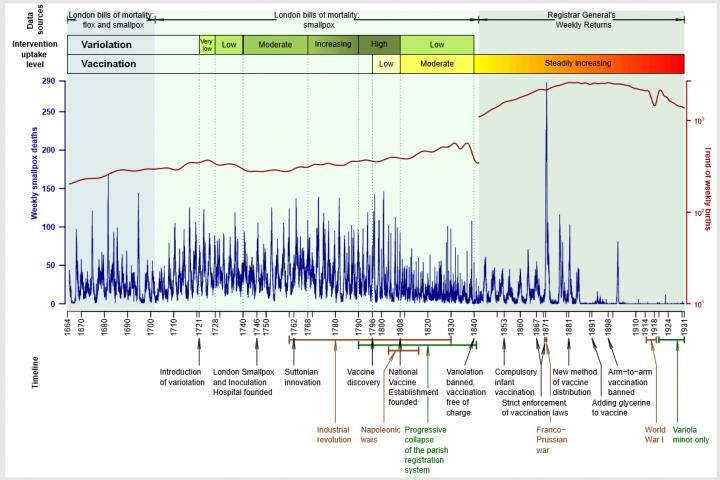
Credit: Olga Krylova and David J.D. Earn
The current COVID-19 pandemic has caused a surge of interest in the study of infectious disease transmission, and how control measures could change the course of the pandemic. New research published on 21st December 2020, in the open access journal PLOS Biology, authored by Olga Krylova of the Canadian Institute for Health Information and David Earn of McMaster University, examines the history of recorded smallpox epidemics in London.
Smallpox, one of the most devastating viral diseases ever to strike humankind, is one of only two infectious diseases that have been successfully eradicated by human efforts. 2020 marks the 40th anniversary of smallpox eradication.
Krylova and Earn studied more than 13,000 weekly smallpox mortality records, from 1664 to 1930, and found that the time between epidemics, the size of the outbreaks, and even the season when the epidemics occurred, changed over the centuries. They also annotated the smallpox time series with major historical events, including the introduction of various control interventions, before and after the discovery of a vaccine in 1796.
The most common pre-vaccination intervention was variolation, which is the practice of carefully controlled intentional infection with a small dose of live virus, leading to immunity with lower risk of death than from natural infection. Variolation has made news recently because it has been suggested that “variolation” with COVID-19 might be occurring as a beneficial side-effect of the use of masks.
The researchers digitized the weekly records published in the London Bills of Mortality and the Registrar General’s Weekly Returns. These data provide a rare and valuable source for the study of ecology and evolution of infectious diseases.
“Our goal was to describe and make publicly available the weekly time series of smallpox mortality in London, and to identify historical events that might have influenced smallpox dynamics over the centuries,” says author David Earn, a professor of mathematics who specializes in modelling of infectious disease transmission.
During the time period covered by the data, smallpox changed from a terrifying and unavoidable danger to an easily preventable infection. Introduction of better control measures, especially vaccination, naturally led to decreased smallpox mortality and eventually eradication. Krylova and Earn present the first statistical analyses of these extraordinary, weekly historical records.
###
Peer reviewed; Observational study; People
In your coverage please use these URLs to provide access to the freely available articles in PLOS Biology: http://journals.
Citation: Krylova O, Earn DJD (2020) Patterns of smallpox mortality in London, England, over three centuries. PLoS Biol 18(12): e3000506. https:/
Funding: Natural Sciences and Engineering Research Council of Canada (NSERC, http://www.
Competing Interests: The authors have declared that no competing interests exist.
Media Contact
David Earn
[email protected]
Related Journal Article
http://dx.




